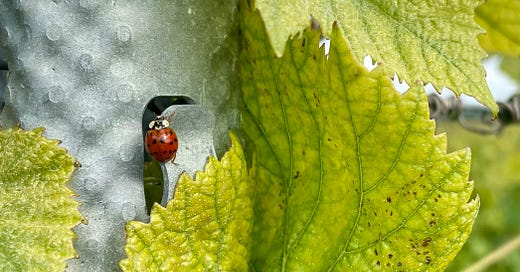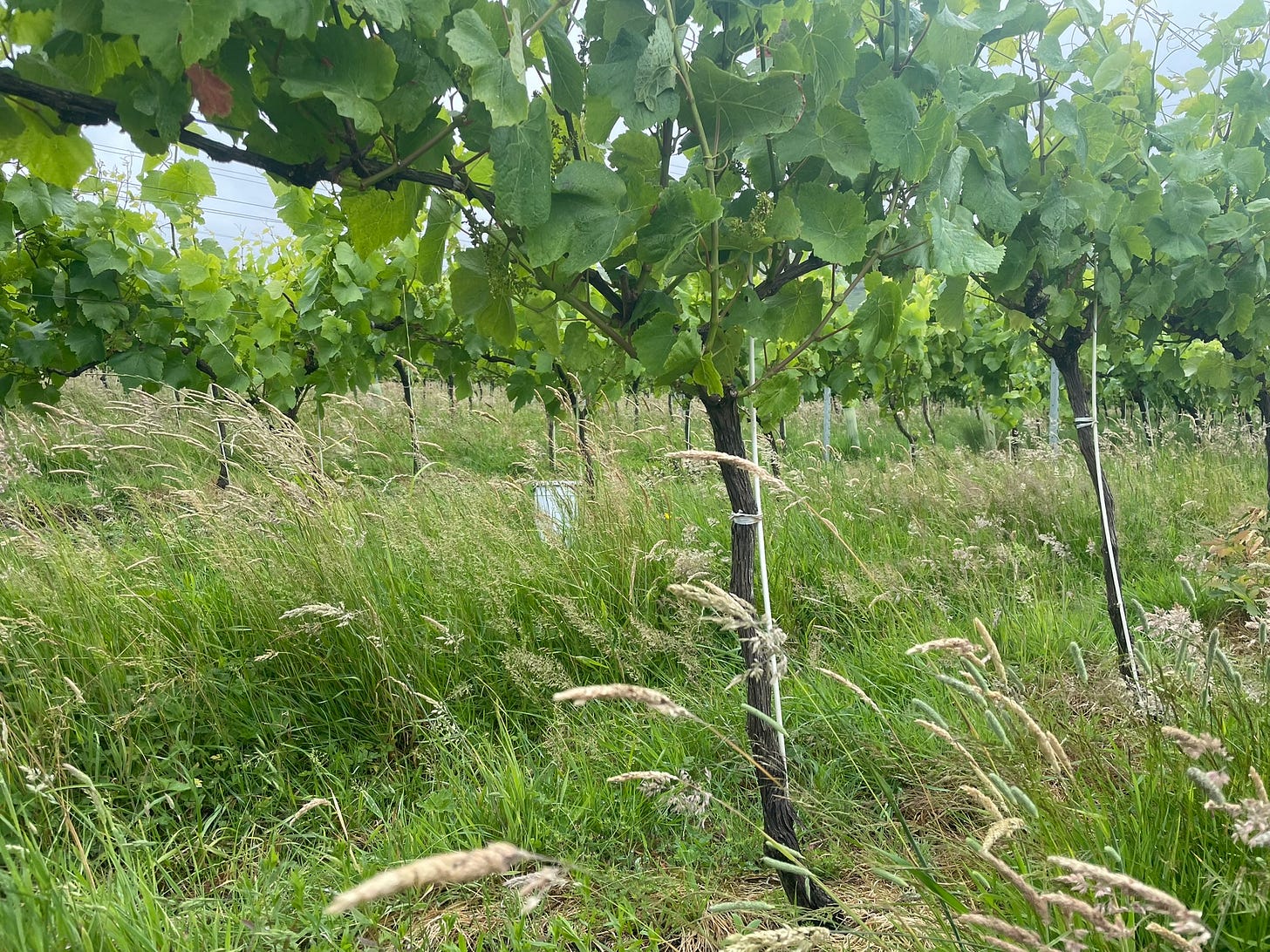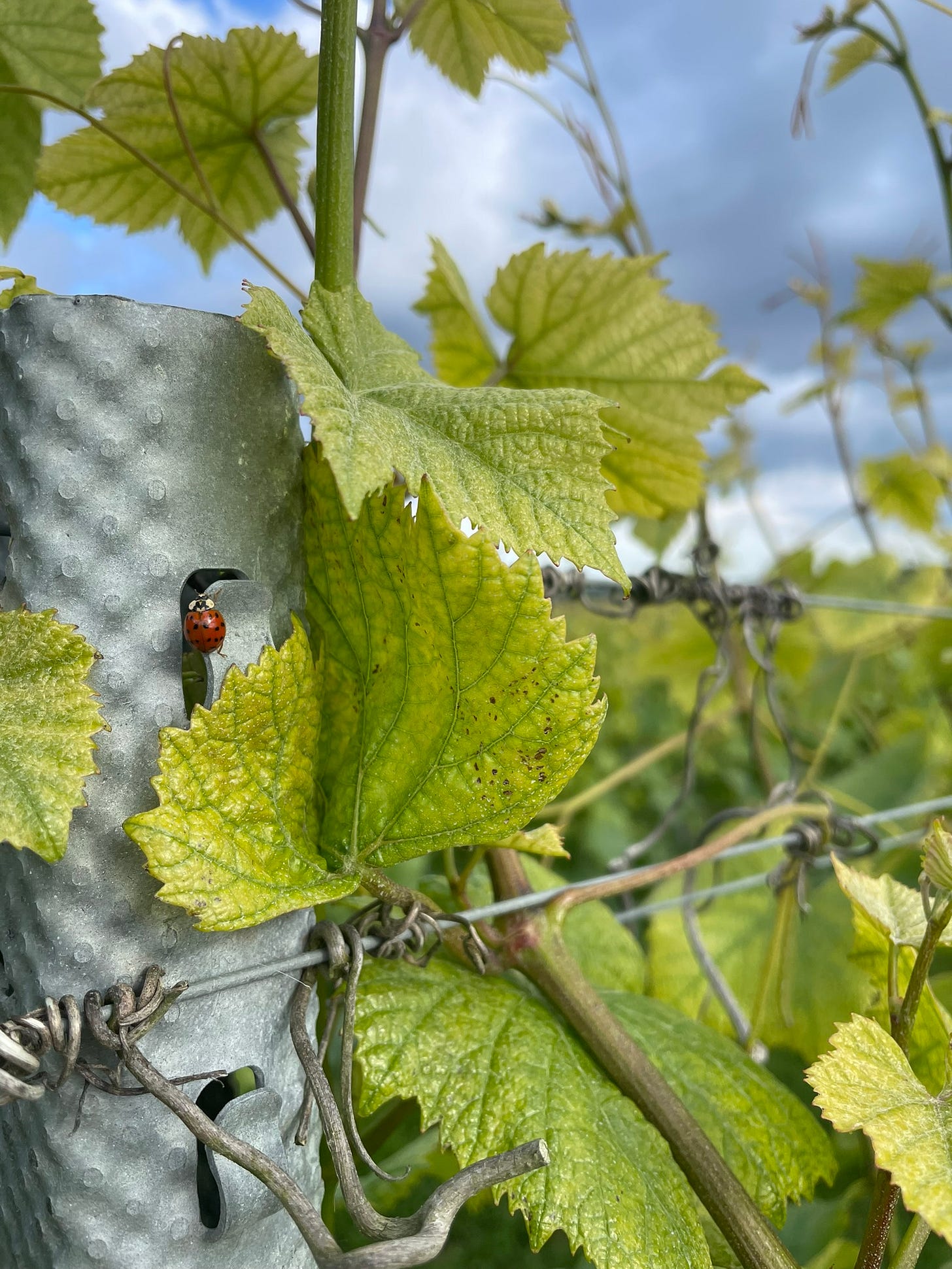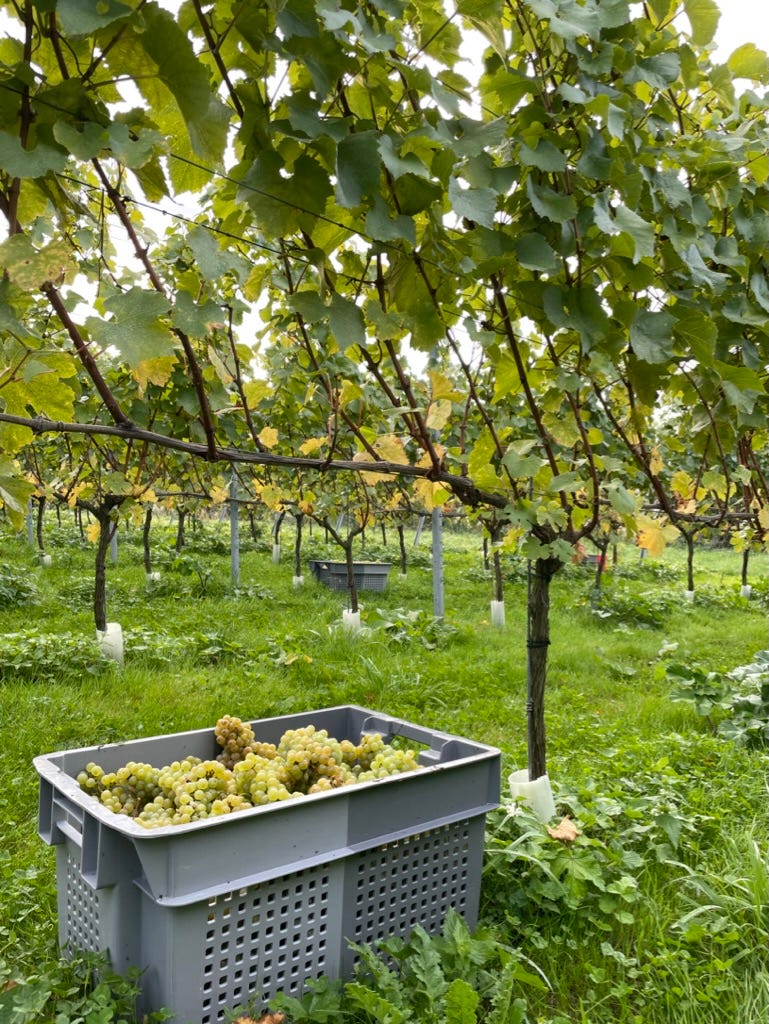In July I researched and wrote my WSET diploma paper on the subject of regenerative viticulture. I was super pleased with the subject and spoke to some winemaking friends to learn more. A huge thank you to them all; Luke Spalding at Everflyt, Richard Woodfine at Woodfine Wines, Hugo Stewart at Domaine Hugo, and Lucie and Jules at Ham Street Wines.
Below is the paper I wrote between packing moving boxes and attending the Olympics. Any questions/corrections/objections/recommendations, I’d love to hear them!
Introduction
Regenerative Viticulture (RV), the application of Regenerative Agriculture (RA) to the growing of grapevines for wine, is a response to the to 20th century’s agrochemical-fuelled degenerative farming practices in the hunt for profit at the cost of ecology. A system where any problem has a solution available for purchase, which often causes other problems, for which another solution is available to purchase. This spiralling effect results in high-dependency on agrochemical companies and the products they provide; always chasing higher yields.
RV takes a step back from yield-focused, expensive and destructive agrochemical-fuelled farming and asks if there’s a way to support nature to create healthy, resilient, productive vines which can not only sustain the planet and its ecosystems, but improve them. The focus shifts from achieving a great yield of grapes this year and towards regenerating ecosystems through the method of farming.
RV aims to do this through employment of RA’s 5 main principles:
Diversity
Livestock integration
Protect soil surface
Minimise soil disturbance
Maintain living roots
Farmers that employ these principles do so in order to achieve positive soil effects, locally and globally, including:
increased organic matter, and therefore carbon sequestration
improved soil structure, temperature, and humidity, enabling development of hyphae fungus
increased biodiversity in the soil, therefore aeration of the soil and greater availability of nutrients
Aims of regenerative viticulturists in England
In this paper I’ll explore the implementation of RV at four different winegrowers across the South of England’s cool maritime climate. I’ll talk about their aims, and the means by which they achieve those. I’ll discuss the commercial impact of these aims; whether that’s the positive or negative impact on cost of production, or any effect RV might have on the demand side. Finally, I’ll offer a personal opinion about the future of RV, whether it has one and how it might evolve to ensure we can continue to enjoy this important and delicious cultural product while protecting the future of this planet we call home.
Soil health as a driver of plant health
A common theme across all producers isthat of soil health as a driver for plant health. The idea that in order for the vine to flourish, it must sit in flourishing soils. Well-draining, aerated, water-holding, biodiverse soils that have high proportions of organic matter and availability of nutrients. Soils that support the development of hyphae fungi, arbuscular mycorrhizal fungi (AMF), that can communicate within and across plant species to share nutrients and alert each other to the presence of pests or disease.
These two benefits, sharing nutrients and alerting each other, are good for vinifera’s all too fraught fight against disease. In the first instance, a healthy strong, well-fed plant is less likely to become a victim of disease (Nicolás et al., 2015, 1084-1096). Producers I spoke to monitored this through a few tests throughout the year; soil analyses to test the availability of nutrients in the soil; leaf nutrient analysis of old and young leaves to assess how well plants are taking up nutrients; and sap sugar-level analysis as a rule-of-thumb predictor of plant health.
Observation was a key tenet of the producers I spoke to. Hugo Stewart (Domaine Hugo and previously Les Clos Perdus) told me that his uncle, the previous farmer at Botleys, used to say the best fertiliser is the farmer’s boots on the ground. This observation enables producers to intervene only as and when necessary, reducing inputs and activity, and leaving nature to flourish. When regenerative producers do observe a problem, they’d sooner come up with a more natural and longer-term fix. This could mean addressing a lack of nitrogen by direct-drilling a nitrogen fixing cover crop such as clover, for example. Interventions would only be implemented when a plant health problem is foreseen.
When plant health isn’t enough to protect a vine from attack the second benefit, of well-connected soils, kicks in. As a vine is under attack, its pattern recognition receptors notice this, triggering a response from the plant to defend itself through strengthening its cell walls and releasing enzymes and phytoalexins to combat the attacker. Selflessly, the vine also signals this attack not only to other parts of the plant, but to other plants through the release of plant signalling molecules. Thanks to the presence of AMF, other plants are alerted and are able to prepare before an attack on them has even begun (Goode, 2022, 124-125).
Three main RA principles help ensure these all important AMF can survive and thrive. Year-round cover crops help protect soil surface, keeping soils humid and not too hot, as well as maintaining living roots which can feed soils through photosynthesis and provide a home and nutrients for AMF. Further, minimising soil disruption through elimination of ploughing or tilling helps retain whatever AMF and ecosystem has already made a home in the soil.
Plant longevity
One of the most destructive parts of modern viticulture is the preparation for planting. It also happens to be quite expensive in terms of both production cost and opportunity cost that comes with having to take the field out of production for ground prep and the few establishing years before a full crop can be taken. If we consider a vineyard to be fully productive for 25 years, with 6 years of establishment before full productivity, that’s about 16% of a vineyard’s life that isn’t fully-productive.
At Everflyt, Luke Spalding is implementing RV principles to try to extend the productive life of the vine. By creating healthy soils and increasing biodiversity to improve vine health, he hopes to delay the need to replant. With less frequent planting come various environmental, namely destruction of soil structure and life alongside carbon emission, as well as commercial benefits.
Healthy, interesting soils to make healthy, interesting wines
Hugo Stewart is a strong believer that live, active, and diverse soils lead to live, active and diverse wines. For him, regenerative is all about creating healthy and resilient plants, not just in a goal in and of itself, but as a means for producing great wine. “You should be thinking, not in terms of growing grapes but in growing wine” is an important tenet of his, refusing to fall for the obsession over big yields. Given his recent success at WineGB, winning the Best Vintage Classic Cuvée Trophy (WineGB, 2024), something seems to be working.
Minimising carbon impact
In talking to English viticulturists, none of them expressed an explicit interest in improving their carbon impact in the vineyard, given the perceived carbon sequestration capability of the thousands of vines. The expectation among RV producers, however, may be that by increasing organic matter, which is naturally ~50% carbon (Pribyl, 2010), carbon sequestration would improve.
Further, the focus on only acting when needed to and reducing inputs, which sometimes have carbon-costly supply chains, can help improve a winery’s carbon impact. Richard, from Woodfine Wines, told me “I’d much rather live at the stress end and adjust up than overdose”.
When treatment is deemed necessary, two producers I spoke with used modified lighter-weight vehicles, a quad bike and a ride-on lawnmower, for sprays. As well as reducing soil compaction, these also burn less hydrocarbon fuel, improving carbon impact compared to heavy tractors.
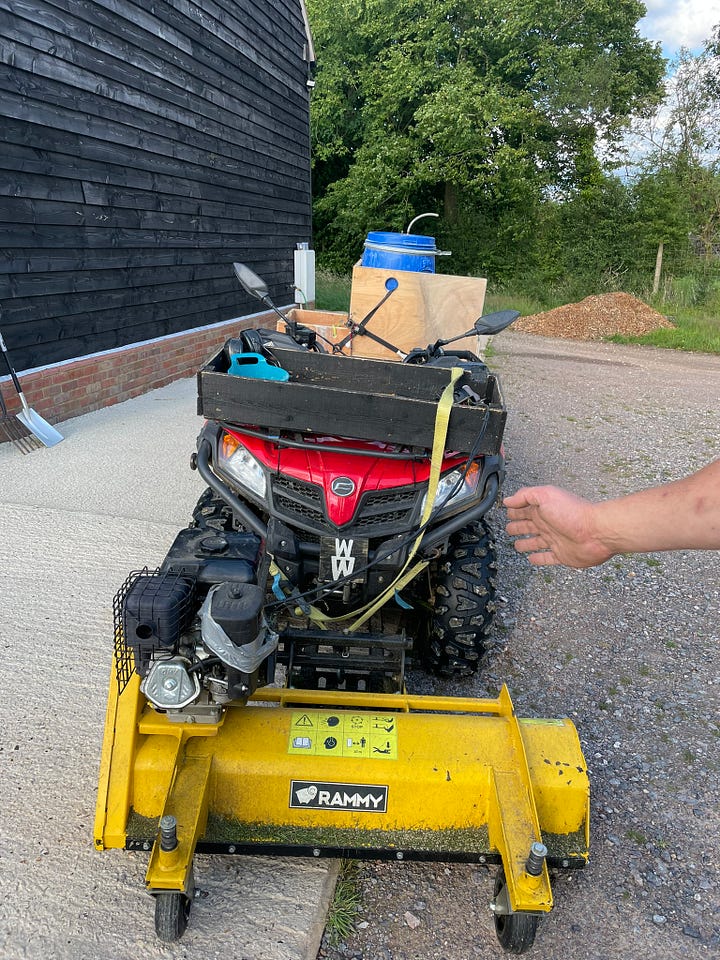
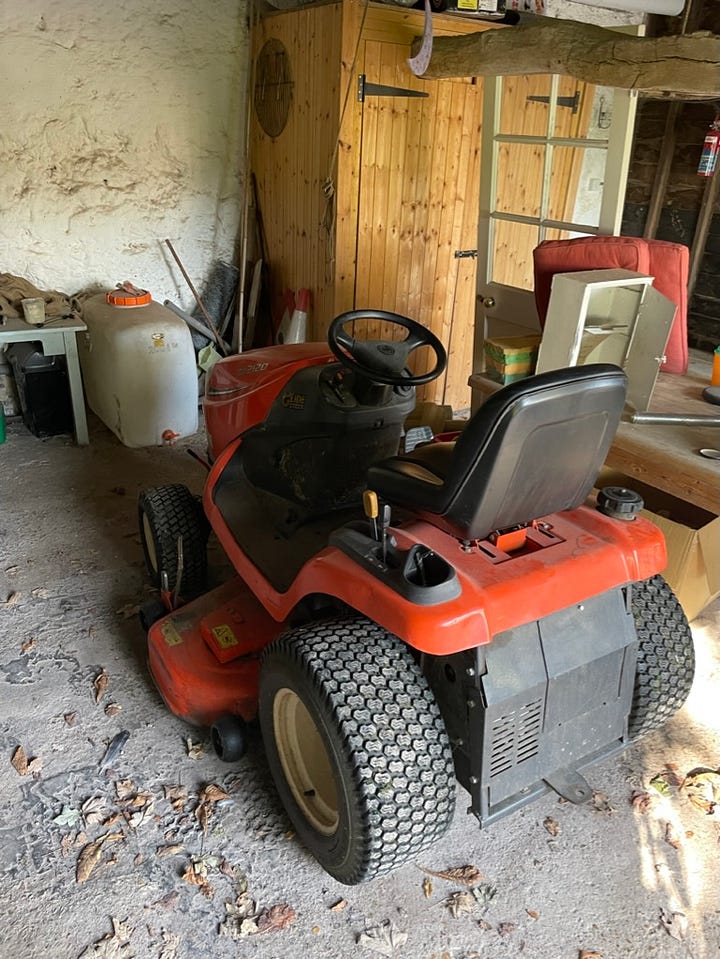
Livestock integration and diversity
Woodfine’s experience with chickens in the vineyard has only been positive. Mobile grazing during the winter helps maintain the vineyard floor, preventing need for mowing, and fertilising the soil.
Likewise, but with a bit more risk, Hugo grazes Shropshire sheep over winter. While the Shropshire sheep tend to ground graze more than feed from trees/vines, there is the risk that they try to and damage the vine. Further, organic certification limits how long Hugo can graze non-organic sheep in the vineyard. Because sheep pastures are very rarely certified organic, finding organic sheep is very difficult.
While grazing livestock may reduce the need to mow, and therefore reduce fuel use (107: How Grazing Sheep Can Benefit Your Vineyard, 2021), I’ve not found any studies that consider the emissions of the livestock, or any additional feed they might need.
Ecological conservation
Increasing biodiversity and the ecological value of the land was an explicit aim of many of the producers I spoke to. And although they may feel it’s the ‘right thing to do’, there are many benefits to increased biodiversity. Whether it’s biodiversity in soil that improves the soil’s availability of nutrients, beneficial insects that eat things like aphids or even downy mildew, bats that eat light brown apple moths, or birds of prey that dissuade flocks of starlings. Biodiversity is another example where nature can provide the solution. The job of the viticulturist is to support nature to find balance.
Leverage hybrid’s natural defences to reduce impact from spraying
Spraying is often a criticism of organic viticulture, the sense that because products aren’t systemic, the viticulturist will have to spray more frequently. The sustainability concern is that it uses more product, compacts soil more, which will need ploughing, and burns more diesel. All but one of the producers I spoke to were certified organic, none of them plough. Further, the number of sprays they’re doing, roughly every two weeks during the growing season and 14 passes in a year, is comparable to WineGB’s conventional spray regime (WineGB, 2023). That said, most of them were also actively trying to reduce their number of sprays, through ways which have already been introduced.
By far and away the most effective way to reduce sprays is by planting naturally resistant varieties. For more than a century, hybrids, some which are referred to as PIWIs, have been bred to contain the necessary R genes to resist mildews and botrytis. A quarter of Woodfine’s vineyard is planted with PIWIs; Cabernet Noir, Cabernet Blanc, and Sauvignac. In five years they’ve had no sprays and remain as healthy as all the pure vinifera. This has effectively reduced their spraying impact by 25%.
Richard’s decision to plant these was inspired by a post-lockdown trip to Plumpton, where the abandoned vinifera vines were all terribly infested, yet PIWIs remained healthy. Though some may be worried about the long-term ability of newer varieties to maintain their resistance, I’ve yet to see a better way to farm regeneratively than growing what grows well with limited human intervention.
A commentary on the commercial advantages and disadvantages
How do you make a small fortune in the wine industry? Start with a big fortune.
None of the producers I spoke to were in it for the money. They love what they do and hope to get by. Some might expect that more responsible farming costs more; higher disease pressure reduces yields, higher labour costs, and reduced productivity of land. While there may be some truth to increased labour costs, the producers I spoke to saw that as an investment, and part of regenerating their community. The general theme of my conversations about commercials was one of short-term investment, for long-term gains. Although it might be hard for people to get off the conventional viticulture treadmill (Groundswell & Masters, 2024), great things are possible once they do.
Reduced farming efforts and inputs
One of the big costs for viticulturists is feed, plant protection products (PPPs), and fuel for machinery to apply these.
Reduced costs of feed and fertiliser
In RV viticulturists rely on natural, long-term solutions for improving vine health. Cover crops can help photosynthesise and feed the soils. They can make homes for bacteria that fix nitrogen. They can help keep the ground moist and cool to cultivate AMF. At some point their biomass can decompose and add nutrients and organic matter to the soil, or be used to create foliar feed sprays, for example from comfrey or nettles. With perennial cover crops this can mean sowing once and forever drastically reducing your need for expensive fertilisers.
In the same vein as biodynamics, creating a metaphorical bubble around the farm and returning nutrients to the soil can be beneficial both for vine and balance sheet. A quarter of Woodfine’s sprays, for example, are biodynamic preparations 100% sourced cost-free from the surroundings.
Reduced cost of PPPs
The healthier the plant, the fewer PPPs are needed, hence the focus on plant health. Investment in building and maintaining a healthy AMF network helps the vineyard become more resilient to microbial attack (Nicolás et al., 2015). With healthier, well-connected vines comes a lower reliance on PPPs, and therefore much lower spend on PPPs. Further, as the need for spraying PPPs goes down, the number of sprays in a year may also go down, bringing fuel costs down, too. Especially when the viticulturist is only spaying when needed.
Reduced machinery cost
Observation, and acting only when needed, as previously discussed, can help regenerative viticulturists spray less than regime-driven organic viticulturists, and no more than conventional viticulturists. Though not strictly a RV practice, the use of light weight vehicles can also help save on fuel costs. Further, smaller equipment is cheaper to buy than specialised vineyard tractors.
Hybrids as the ultimate PPP reducer
Some hybrids, or PIWIs, contain the appropriate R genes in order to confer natural resistance to mildews and botrytis. Though there may be no one variety that is fully resistant to all possible diseases, they can drastically help reduce the need for spraying and therefore reduce the associated labour and input costs.
At Woodfine, for example, having 25% of the vines as PIWIs means a very simple 25% reduced PPP cost and 25% time saving on spraying.
Reduce need for replanting
As previously discussed, Everflhyt are trying to extend the productive life of a vine so as to reduce the need, and therefore environmental and commercial costs, of replanting. Delaying the need to replant by 10 years, which may well be possible through better cared-for and healthier vines, has obvious benefits. A higher proportion of productivity from a field’s lifecycle means better return on the planting investment. Likewise, having to plant once every 40 years, instead of 30, would effectively be a 33% saving on planting costs.
Yields and profitability
Although some studies may suggest organic agriculture produces lower yields than conventional (Alvarez, 2021), I was unable to find any studies specifically about regenerative viticulture. Anecdotally, the producers I spoke to report very respectable yields compared to their conventional colleagues.
Moreover, for a luxury product like wine, the size of the yield is not the goal. That said, it’s clear to see how a lower yield will result in higher prices. The premium often associated with organic viticulture, where production costs are similar but a greater proportion is on labour, can make organic farming more profitable (Crowder & Reganold, 2015, 7611-7616). Specifically with respect to RA in corn, not grapes, while yields were shown to be down 29%, profitability was 78% higher (LaCanne & Lundgren, 2018, e4428). That more of the money is spent on labour, rather than products of capital, is a further benefit helping regenerate farming communities.
For some this profitability may be explained by a consumer’s willingness to pay more for sustainable products (Delmas & Grant, 2010), though that is contested (Sogari et al., 2016, 58-64), Hugo Stewart’s belief is that RV helps to produce more interesting wine. Given the premium quality, they’re able to charge a premium price.
Capture a growing market
The other demand side consideration is that of being able to convert or attract customers that are sustainably-minded and whose product choices may be informed by the responsibility of the supply chain.
Nature conservation grants
Another point on the demand side is that of the availability of nature conservation grants. With schemes like Countryside Stewardship (CS) and Biodiversity Net Gain (BNG), viticulturists are able to generate income, in the form of subsidies, while also generating a source of wildflowers and plants they can use as alternatives to agrochemicals. Under CS this can bring in £1,500 per hectare. More is available through BNG, but a minimum 30-year sign up reduces flexibility and may put off some farmers.
A personal opinion on the future of the approach
Increased prevalence but prone to greenwashing
Given the increase in concerns about both the environmental impact of our lifestyles and the provenance of our food, I believe RV will only continue to grow. Much of this growth, in the coming years, I fear, will be greenwashing. That is to say winegrowers claiming to be regenerative, for the sake of improved perception, without real commitment to the aims or practices previously discussed. The same has already happened to ‘sustainable’, with companies across the globe lauding their sustainability while maintaining deep dependence on hydrocarbons and failing to reduce the waste they and their products produce.
Certification to prevent greenwashing
The challenge for those passionate about RV must, therefore, be how to prevent the dilution of the ‘regenerative’ brand, without overcomplicating things and discouraging producers from dipping their toe in the pool and taking a step in the right direction. Naturally, this would suggest that legislation, or at least certification, is needed to protect correct use of the term. Since even biodynamics, a century old practice, isn’t protected by legislation to the same extent as organics, certification schemes will have to be depended on. Though there are already at least two certifiers in the USA (Regenerative Organic Alliance, Regenified), and between them they have fewer than a few dozen vineyards certified, viticulturists I talked to expressed hesitancy about signing up. The two I asked were already certified organic and biodynamic and stated a third certification would be unnecessary given their existing certifications. Further, concerns were shared about the recognition of the certification. As with any new thing, it needs enough big players to take the dive in order to become recognisable and valued before winegrowers will pay for it.
The hybrids are coming
The other aspect we must consider about the future of RV is that of the practices employed to achieve the aforementioned aims. It seems to me that the easiest way to restore ecosystems, reduce carbon impact, build more resilient vineyards, and reduce inputs and costs has to include new varieties. Whether those are technically hybrids, or new varieties of vinifera that have the necessary R genes to protect them from the dreaded diseases, leveraging innate resistance of vines is the easiest solution. Further, it is one that has a virtuous cycle. With fewer toxic sprays, including sulphur and copper, and fewer passes with even lighter-weight spray vehicles, soil compaction decreases and soil biodiversity will increase even further.
The biggest challenge for producers taking advantage of these innate resistances will be to convince customers to try an unknown variety. Many wine drinkers may not care what variety they’re drinking, so this feels like an easy win. Some premium customers may be closed-minded about trying something new, believing they’ve found what they like. Others, and maybe mostly those that express concerns about sustainability, may be more open-minded to try unknown varieties.
The second challenge, even with open-minded customers, will be to produce a product that will ensure their repeat custom. Having tried some hybrid wines, and lots of vinifera wine, I know that the grape’s species does not predict quality. As more and more viticulturists see the benefits of growing naturally resistant varieties, they and their winemaking colleagues will find better ways of working with each variety both in the vineyard and the winery. I believe all that’s needed is for the recognition of one new variety as a high quality wine for people to become more open minded. As with certification, it will probably need to be an established producer with renown to help legitimise new varieties on the global wine stage. I believe their time will come. The sooner the better, I say.
References
Alvarez, R. (2021, 06 01). Comparing Productivity of Organic and Conventional Farming Systems: A Quantitative Review. Archives of Agronomy and Soil Science, 68(14), -. 10.1080/03650340.2021.1946040
Capalbo, C. (2008, June 4). Claude and Lydia Bourguignon: Famous chateau secrets. Decanter. Retrieved July 27, 2024, from https://www.decanter.com/features/claude-and-lydia-bourguignon-famous-chateau-secrets-247201/
Celce, B. (2013, June 23). Wine Tasting, Vineyards, in France: Business as usual in Champagne. Wine Terroirs. Retrieved July 27, 2024, from https://www.wineterroirs.com/2013/06/champagne_conventional_farming_vineyards_spraying.html
Crowder, D. W., & Reganold, J. P. (2015, 05 1). Financial competitiveness of organic agriculture on a global scale. PNAS, 112(24), 7611-7616. https://doi.org/10.1073/pnas.1423674112
Delmas, M. A., & Grant, L. E. (2010). Eco-Labeling Strategies and Price-Premium: The Wine Industry Puzzle. Business & Society, March(2010), 1-42. https://ssrn.com/abstract=2154001
Goode, J. (2022). Regenerative Viticulture. Amazon Digital Services LLC - Kdp. 9000
Groundswell & Masters, N. (2024, May 31). Nicole Masters at Groundswell 2023 - Get inspired about agriculture again! YouTube. Retrieved July 27, 2024, from
LaCanne, C., & Lundgren, J. (2018). Regenerative agriculture: Merging farming and natural resource conservation profitably. PeerJ, 6(2), e4428. 10.7717/peerj.4428
Nicolás, E., MAESTRE-VALERO, J., & ALARCÓN, J. (2015). Effectiveness and persistence of arbuscular mycorrhizal fungi on the physiology, nutrient uptake and yield of Crimson seedless grapevine. Agricultural science, 153(6), 1084-1096. 10.1017/S002185961400080X
107: How Grazing Sheep Can Benefit Your Vineyard. (2021, 05 01). Vineyard Team. Retrieved July 30, 2024, from https://www.vineyardteam.org/resources/resource-library/conservation-and-enhancement-of-biological-diversity.php?id=895
Pribyl, D. (2010). A critical review of the conventional SOC to SOM conversion factor. Geoderma, 156(3-4), 75-83. https://doi.org/10.1016/j.geoderma.2010.02.003
Sogari, G., Mora, C., & Menozzi, D. (2016). Sustainable Wine Labeling: A Framework for Definition and Consumers’ Perception. Agriculture and Agricultural Science, 8(-), 58-64. 10.1016/j.aaspro.2016.02.008
WineGB. (2023, 03 01). The Green Book. WineGB. https://winegb.co.uk/wp-content/uploads/2023/03/The-Green-Book-2023-FINAL.pdf
WineGB. (2024, July 19). WineGB Awards 2024 trophy winners announced. WineGB. Retrieved 07 28, 2024, from https://winegb.co.uk/press-releases/winegb-awards-2024-trophy-winners-announced/

